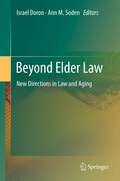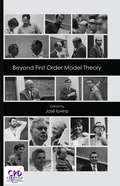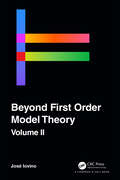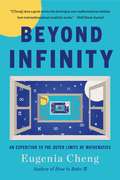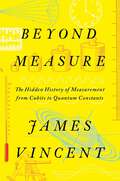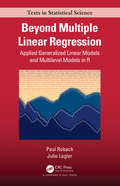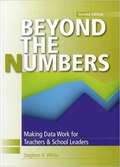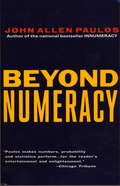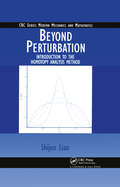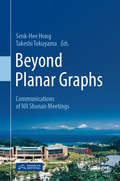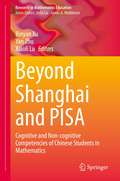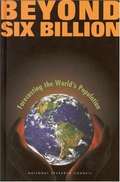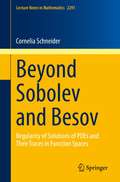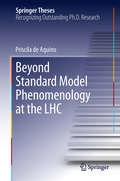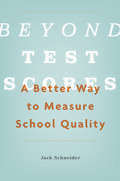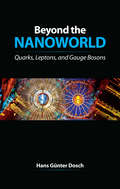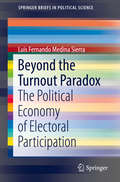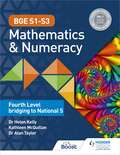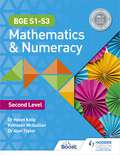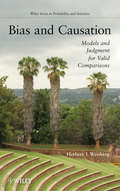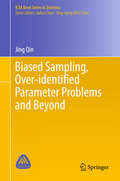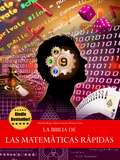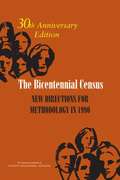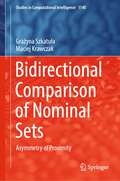- Table View
- List View
Beyond Elder Law: New Directions in Law and Aging
by Ann M. Soden Israel DoronAll over the world, there is a growing interest in the relationship between law and aging: How does the law influence the lives of older people? Can rights, advocacy and representation advance the social position of the aged and combat ageism? What are the new and cutting-edge frontiers in the field of elder law? Should there be a new international human rights convention in this field? These are only a few of the many questions that arise. This book attempts to answer some of these questions and to set the agenda for the future development of elder law across the globe. Taking into account existing research and knowledge, leading scholars from different continents (North America, Europe, Asia, and Australia) present in this book original and novel ideas regarding the future development of elder law. These ideas touch upon key topics such as elder guardianship, citizenship, mental capacity, elder abuse, human rights and international law, family relationships, age discrimination, and the right to die. This book can thus serve as an important reference work for all those interested in understanding where law and aging are headed, and for those concerned about the future legal rights of older persons.
Beyond First Order Model Theory, Volume I
by Jose IovinoModel theory is one of the central branches of mathematical logic. The field has evolved rapidly in the last few decades. This book is an introduction to current trends in model theory, and contains a collection of articles authored by top researchers in the field. It is intended as a reference for students as well as senior researchers.
Beyond First Order Model Theory, Volume II
by José IovinoModel theory is the meta-mathematical study of the concept of mathematical truth. After Afred Tarski coined the term Theory of Models in the early 1950’s, it rapidly became one of the central most active branches of mathematical logic. In the last few decades, ideas that originated within model theory have provided powerful tools to solve problems in a variety of areas of classical mathematics, including algebra, combinatorics, geometry, number theory, and Banach space theory and operator theory. The two volumes of Beyond First Order Model Theory present the reader with a fairly comprehensive vista, rich in width and depth, of some of the most active areas of contemporary research in model theory beyond the realm of the classical first-order viewpoint. Each chapter is intended to serve both as an introduction to a current direction in model theory and as a presentation of results that are not available elsewhere. All the articles are written so that they can be studied independently of one another. This second volume contains introductions to real-valued logic and applications, abstract elementary classes and applications, interconnections between model theory and function spaces, nonstucture theory, and model theory of second-order logic. Features A coherent introduction to current trends in model theory. Contains articles by some of the most influential logicians of the last hundred years. No other publication brings these distinguished authors together. Suitable as a reference for advanced undergraduate, postgraduates, and researchers. Material presented in the book (e.g, abstract elementary classes, first-order logics with dependent sorts, and applications of infinitary logics in set theory) is not easily accessible in the current literature. The various chapters in the book can be studied independently.
Beyond Hyperbolicity (London Mathematical Society Lecture Note Series #454)
by Mark Hagen Richard Webb Henry WiltonSince the notion was introduced by Gromov in the 1980s, hyperbolicity of groups and spaces has played a significant role in geometric group theory; hyperbolic groups have good geometric properties that allow us to prove strong results. However, many classes of interest in our exploration of the universe of finitely generated groups contain examples that are not hyperbolic. Thus we wish to go 'beyond hyperbolicity' to find good generalisations that nevertheless permit similarly strong results. This book is the ideal resource for researchers wishing to contribute to this rich and active field. The first two parts are devoted to mini-courses and expository articles on coarse median spaces, semihyperbolicity, acylindrical hyperbolicity, Morse boundaries, and hierarchical hyperbolicity. These serve as an introduction for students and a reference for experts. The topics of the surveys (and more) re-appear in the research articles that make up Part III, presenting the latest results beyond hyperbolicity.
Beyond Infinity: An Expedition to the Outer Limits of Mathematics
by Eugenia ChengThe hilarious and charming Eugenia Cheng leads us in search of what's bigger than infinity, and smaller than its oppositeImagine something small enough to fit in your head but too large to fit in the world-or even the universe. What would you call it? And what would it be? How about...infinity? In Beyond Infinity, musician, chef, and mathematician Eugenia Cheng answers this question by taking readers on a startling journey from math at its most elemental to its loftiest abstractions. Beginning with the classic thought experiment of Hilbert's hotel-the place where you can (almost) always find a room, if you don't mind being moved from room to room over the course of the night-she explores the wild and woolly world of the infinitely large and the infinitely small. Along the way she considers weighty questions like why some numbers are uncountable or why infinity plus one is not the same as one plus infinity. She finds insight in some unlikely examples: planning a dinner party for 7 billion people using a chessboard, making a chicken-sandwich sandwich, and creating infinite cookies from a finite ball of dough all tell you more about math than you could have imagined. An irresistible book on the universe's biggest possible topic, Beyond Infinity will beguile and bewitch you, and show all of us how one little symbol can hold the biggest idea of all.
Beyond Measure: The Hidden History Of Measurement From Cubits To Quantum Constants
by James VincentA vibrant account of how measurement has invisibly shaped our world, from ancient civilizations to the modern day. From the cubit to the kilogram, the humble inch to the speed of light, measurement is a powerful tool that humans invented to make sense of the world. In this revelatory work of science and social history, James Vincent dives into its hidden world, taking readers from ancient Egypt, where measuring the annual depth of the Nile was an essential task, to the intellectual origins of the metric system in the French Revolution, and from the surprisingly animated rivalry between metric and imperial, to our current age of the “quantified self.” At every turn, Vincent is keenly attuned to the political consequences of measurement, exploring how it has also been used as a tool for oppression and control. Beyond Measure reveals how measurement is not only deeply entwined with our experience of the world, but also how its history encompasses and shapes the human quest for knowledge.
Beyond Multiple Linear Regression: Applied Generalized Linear Models And Multilevel Models in R (Chapman & Hall/CRC Texts in Statistical Science)
by Paul Roback Julie LeglerBeyond Multiple Linear Regression: Applied Generalized Linear Models and Multilevel Models in R is designed for undergraduate students who have successfully completed a multiple linear regression course, helping them develop an expanded modeling toolkit that includes non-normal responses and correlated structure. Even though there is no mathematical prerequisite, the authors still introduce fairly sophisticated topics such as likelihood theory, zero-inflated Poisson, and parametric bootstrapping in an intuitive and applied manner. The case studies and exercises feature real data and real research questions; thus, most of the data in the textbook comes from collaborative research conducted by the authors and their students, or from student projects. Every chapter features a variety of conceptual exercises, guided exercises, and open-ended exercises using real data. After working through this material, students will develop an expanded toolkit and a greater appreciation for the wider world of data and statistical modeling. A solutions manual for all exercises is available to qualified instructors at the book’s website at www.routledge.com, and data sets and Rmd files for all case studies and exercises are available at the authors’ GitHub repo (https://github.com/proback/BeyondMLR)
Beyond The Numbers: Making Data Work For Teachers And School Leaders
by Stephen H. WhiteBeyond The Numbers will help teachers and school leaders make wise decisions with imperfect data. It will help educators apply their collective wisdom and professional judgement through proven, established components delineated in each chapter. New topics covered include Common Core Sate Standards, new assessment systems designed to improve instruction as much as accountability, value-added student growth models and the evaluation of teacher effectiveness in terms of student achievement gains.
Beyond Numeracy
by John Allen PaulosFrom the author of the national bestseller Innumeracy, a delightful exploration and explanation of mathematical concepts from algebra to zero in easily accessible alphabetical entries. "Paulos . . . does for mathematics what The Joy of Sex did for the boudoir. . . ."--Washington Post Book World. First time in paperback.
Beyond Perturbation: Introduction to the Homotopy Analysis Method (Modern Mechanics and Mathematics)
by Shijun LiaoSolving nonlinear problems is inherently difficult, and the stronger the nonlinearity, the more intractable solutions become. Analytic approximations often break down as nonlinearity becomes strong, and even perturbation approximations are valid only for problems with weak nonlinearity. This book introduces a powerful new analytic method for nonlinear problems-homotopy analysis-that remains valid even with strong nonlinearity. In Part I, the author starts with a very simple example, then presents the basic ideas, detailed procedures, and the advantages (and limitations) of homotopy analysis. Part II illustrates the application of homotopy analysis to many interesting nonlinear problems. These range from simple bifurcations of a nonlinear boundary-value problem to the Thomas-Fermi atom model, Volterra's population model, Von Karman swirling viscous flow, and nonlinear progressive waves in deep water. Although the homotopy analysis method has been verified in a number of prestigious journals, it has yet to be fully detailed in book form. Written by a pioneer in its development, Beyond Pertubation: Introduction to the Homotopy Analysis Method is your first opportunity to explore the details of this valuable new approach, add it to your analytic toolbox, and perhaps make contributions to some of the questions that remain open.
Beyond Planar Graphs: Communications of NII Shonan Meetings
by Seok-Hee Hong Takeshi TokuyamaThis book is the first general and extensive review on the algorithmics and mathematical results of beyond planar graphs. Most real-world data sets are relational and can be modelled as graphs consisting of vertices and edges. Planar graphs are fundamental for both graph theory and graph algorithms and are extensively studied. Structural properties and fundamental algorithms for planar graphs have been discovered. However, most real-world graphs, such as social networks and biological networks, are non-planar. To analyze and visualize such real-world networks, it is necessary to solve fundamental mathematical and algorithmic research questions on sparse non-planar graphs, called beyond planar graphs.This book is based on the National Institute of Informatics (NII) Shonan Meeting on algorithmics on beyond planar graphs held in Japan in November, 2016. The book consists of 13 chapters that represent recent advances in various areas of beyond planar graph research. The main aims and objectives of this book include 1) to timely provide a state-of-the-art survey and a bibliography on beyond planar graphs; 2) to set the research agenda on beyond planar graphs by identifying fundamental research questions and new research directions; and 3) to foster cross-disciplinary research collaboration between computer science (graph drawing and computational geometry) and mathematics (graph theory and combinatorics). New algorithms for beyond planar graphs will be in high demand by practitioners in various application domains to solve complex visualization problems. This book therefore will be a valuable resource for researchers in graph theory, algorithms, and theoretical computer science, and will stimulate further deep scientific investigations into many areas of beyond planar graphs.
Beyond Shanghai and PISA: Cognitive and Non-cognitive Competencies of Chinese Students in Mathematics (Research in Mathematics Education)
by Binyan Xu Yan Zhu Xiaoli LuThis book seeks to illustrate the research on mathematics competencies and disposition in China according to the conceptual development and empirical investigation perspective. Mathematics education in China has a distinguishing feature a focus of attention to mathematical competency. Paradoxically, there has not been an explicit, refined, and measurable evaluation system in place to assess mathematical competency in China. While academic achievement surveys or evaluations are common, these can only give an overall conclusion about mathematical thinking skills or problem solving abilities. In response to this deficiency, China is beginning to carry out national projects that emphasize defining both a conceptual framework on core competencies in school mathematics and developing a corresponding assessment framework. Thus, the main focus of this volume is the current investigations of different mathematics competencies and mathematical disposition of Chinese students, with the aim of promoting interaction between domestic and international student performance assessment, to provide a more comprehensive understanding of mathematics competencies and disposition in mainland China, and to stimulate innovative new directions in research. The primary audience of this volume is the large group of researchers interested in mathematics competencies, mathematics teaching and learning in China, or comparative studies, or the relation of the three. The book will also appeal to teaching trainers or instructors, as well as be an appropriate resource for graduate courses or seminars at either the master’s or doctoral level.
Beyond Six Billion: Forecasting the World's Population
by National Research CouncilIs rapid world population growth actually coming to an end? As population growth and its consequences have become front-page issues, projections of slowing growth from such institutions as the United Nations and the World Bank have been called into question. Beyond Six Billion asks what such projections really say, why they say it, whether they can be trusted, and whether they can be improved. The book includes analysis of how well past U.N. and World Bank projections have panned out, what errors have occurred, and why they have happened.Focusing on fertility as one key to accurate projections, the committee examines the transition from high, constant fertility to low fertility levels and discusses whether developing countries will eventually attain the very low levels of births now observed in the industrialized world. Other keys to accurate projections, predictions of lengthening life span and of the impact of international migration on specific countries, are also explored in detail.How good are our methods of population forecasting? How can we cope with the inevitable uncertainty? What population trends can we anticipate? Beyond Six Billion illuminates not only the forces that shape population growth but also the accuracy of the methods we use to quantify these forces and the uncertainty surrounding projections.The Committee on Population was established by the National Academy of Sciences (NAS) in 1983 to bring the knowledge and methods of the population sciences to bear on major issues of science and public policy. The committee's work includes both basic studies of fertility, health and mortality, and migration; and applied studies aimed at improving programs for the public health and welfare in the United States and in developing countries. The committee also fosters communication among researchers in different disciplines and countries and policy makers in government, international agencies, and private organizations. The work of the committee is made possible by funding from several government agencies and private foundations.
Beyond Sobolev and Besov: Regularity of Solutions of PDEs and Their Traces in Function Spaces (Lecture Notes in Mathematics #2291)
by Cornelia SchneiderThis book investigates the close relation between quite sophisticated function spaces, the regularity of solutions of partial differential equations (PDEs) in these spaces and the link with the numerical solution of such PDEs. It consists of three parts. Part I, the introduction, provides a quick guide to function spaces and the general concepts needed. Part II is the heart of the monograph and deals with the regularity of solutions in Besov and fractional Sobolev spaces. In particular, it studies regularity estimates of PDEs of elliptic, parabolic and hyperbolic type on non smooth domains. Linear as well as nonlinear equations are considered and special attention is paid to PDEs of parabolic type. For the classes of PDEs investigated a justification is given for the use of adaptive numerical schemes. Finally, the last part has a slightly different focus and is concerned with traces in several function spaces such as Besov– and Triebel–Lizorkin spaces, but also in quite general smoothness Morrey spaces. The book is aimed at researchers and graduate students working in regularity theory of PDEs and function spaces, who are looking for a comprehensive treatment of the above listed topics.
Beyond Standard Model Phenomenology at the LHC (Springer Theses)
by Priscila De AquinoThis thesis provides an introduction to the physics of the Standard Model and beyond, and to the methods used to analyse Large Hadron Collider (LHC) data. The 'hierarchy problem', astrophysical data and experiments on neutrinos indicate that new physics can be expected at the now accessible TeV scale. This work investigates extensions of the Standard Model with gravitons and gravitinos (in the context of supergravity). The production of these particles in association with jets is studied as one of the most promising avenues for researching new physics at the LHC. Advanced simulation techniques and tools, such as algorithms allowing the computation of Feynman graphs and helicity amplitudes are first developed and then employed.
Beyond Test Scores: A Better Way to Measure School Quality
by Jack SchneiderTest scores are the go-to metric of policy makers and anxious parents looking to place their children in the best schools. Yet standardized tests are a poor way to measure school performance. Using the diverse urban school district of Somerville MA as a case study, Jack Schneider’s team developed a new framework to assess educational effectiveness.
Beyond the Nanoworld: Quarks, Leptons, and Gauge Bosons
by H. G. DoschBeyond the world of atoms, at scales smaller than the smallest nuclei, a new world comes into view, populated by an array of colorful elementary particles: strange and charmed quarks, muons and neutrinos, gluons and photons, and many others, all interacting in beautifully intricate patterns. Beyond the Nanoworld tells the story of how this new real
Beyond the Turnout Paradox
by Luis Fernando Medina SierraThis Brief uses game-theoretic analysis to debunk the turnout paradox and offers an alternative economic model to elucidate the patterns behind the socioeconomic bias in turnout. The author argues that the turnout paradox—the idea that rational, strategic actors would not vote in an election—is an overstated problem, and that, contrary to widespread belief, game-theoretic models of elections with highly realistic parameters are compatible with high turnout. The author applies the method of stability sets to the study of voting games so as to characterize the behavior of electoral turnout in response to the game’s structural parameters. To illustrate the power and potential of this framework, the author then develops a politico-economic model that generates testable theories about the way in which the modern welfare state and redistribution of wealth can shape the patterns of biased turnout that exist in most democracies. By turning a classic problem of rational choice into a source of new methods of analysis this Brief allows game theory to intervene in relevant conversations about the political economy of electoral participation, creating an opportunity for formal methods to make a welcome contribution to the discipline. As such, this Brief will be of use to scholars and student of political science, economics, political economy, and public policy, especially those who work in the tradition of formal methods.
BGE S1–S3 Mathematics & Numeracy: Fourth Level bridging to National 5
by Dr Helen Kelly Dr Alan Taylor Kate McQuillanSyllabus: CfE (Curriculum for Excellence, from Education Scotland) and SQALevel: BGE S1-3: Fourth LevelSubject: Mathematics & NumeracyAim high and build confidence with this rigorous approach. Pupils are guided through mathematical concepts with worked examples, plenty of practice and opportunities to check that skills are secure before moving on.Covering all CfE Fourth Level Benchmarks (with bridging material to prepare for N5), this ready-made and differentiated course puts progression for every pupil at the heart of your curriculum.> Make new learning manageable: Each concept is introduced through step-by-step explanations and progressive worked examples, with proven methods for mastering difficult concepts> Apply knowledge and practise skills: Pupils are encouraged to test and explore their understanding of new concepts by completing exercises that gradually build in difficulty - with answers provided at the back of the book> Lay firm foundations for National qualifications: Key skills required for N5 Maths are covered in greater depth within the context of Fourth Level topics, giving pupils and teachers a head start in S4> Meet the needs of each pupil in your class: The explanations and activities are designed to ensure accessibility for those with low prior attainment, while coverage of higher order thinking skills will challenge and extend high achieving pupils> Effectively check and assess progress: 'Check-up' exercises at the end of each chapter consolidate learning and support formative assessment, helping you to monitor progression against the Experiences & Outcomes and Benchmarks> Deliver the 'responsibility for all' Es and Os: Plenty of activities that address literacy and health and wellbeing skills are threaded through the book
BGE S1–S3 Mathematics & Numeracy: Second Level
by Dr Helen Kelly Kate McQuillan Dr Alan TaylorMotivate and nurture every pupil with bespoke support and inclusive, age-appropriate content for those working towards Second Level Maths in secondary schools.This rigorous approach guides learners through mathematical concepts with worked examples, plenty of practice and opportunities to check that skills are secure before moving on.Covering all CfE Second Level Benchmarks, this ready-made and differentiated course puts progression for all pupils at the heart of your curriculum.> Make new learning manageable: Each concept is introduced through step-by-step explanations and progressive worked examples, with proven methods for mastering more difficult concepts> Apply knowledge and practise skills: Pupils are encouraged to test and explore their understanding of new concepts by completing exercises that gradually build in difficulty - with answers included at the back of the book> Meet the needs of each pupil in your class: The explanations and activities are designed to ensure accessibility for all, while extension tasks provide further stretch and challenge> Effectively check and assess progress: 'Check-up' exercises at the end of each chapter consolidate learning and support formative assessment, helping you to monitor progression against the Experiences & Outcomes and Benchmarks> Deliver the 'responsibility for all' Es and Os: Plenty of activities that address literacy and health and wellbeing skills are threaded through the book
Bias and Causation
by Herbert I. WeisbergA one-of-a-kind resource on identifying and dealing with bias in statistical research on causal effects Do cell phones cause cancer? Can a new curriculum increase student achievement? Determining what the real causes of such problems are, and how powerful their effects may be, are central issues in research across various fields of study. Some researchers are highly skeptical of drawing causal conclusions except in tightly controlled randomized experiments, while others discount the threats posed by different sources of bias, even in less rigorous observational studies. Bias and Causation presents a complete treatment of the subject, organizing and clarifying the diverse types of biases into a conceptual framework. The book treats various sources of bias in comparative studies--both randomized and observational--and offers guidance on how they should be addressed by researchers. Utilizing a relatively simple mathematical approach, the author develops a theory of bias that outlines the essential nature of the problem and identifies the various sources of bias that are encountered in modern research. The book begins with an introduction to the study of causal inference and the related concepts and terminology. Next, an overview is provided of the methodological issues at the core of the difficulties posed by bias. Subsequent chapters explain the concepts of selection bias, confounding, intermediate causal factors, and information bias along with the distortion of a causal effect that can result when the exposure and/or the outcome is measured with error. The book concludes with a new classification of twenty general sources of bias and practical advice on how mathematical modeling and expert judgment can be combined to achieve the most credible causal conclusions. Throughout the book, examples from the fields of medicine, public policy, and education are incorporated into the presentation of various topics. In addition, six detailed case studies illustrate concrete examples of the significance of biases in everyday research. Requiring only a basic understanding of statistics and probability theory, Bias and Causation is an excellent supplement for courses on research methods and applied statistics at the upper-undergraduate and graduate level. It is also a valuable reference for practicing researchers and methodologists in various fields of study who work with statistical data. This book was selected as the 2011 Ziegel Prize Winner in Technometrics for the best book reviewed by the journal. It is also the winner of the 2010 PROSE Award for Mathematics from The American Publishers Awards for Professional and Scholarly Excellence
Biased Sampling, Over-identified Parameter Problems and Beyond
by Jing QinThis book is devoted to biased sampling problems (also called choice-based sampling in Econometrics parlance) and over-identified parameter estimation problems. Biased sampling problems appear in many areas of research, including Medicine, Epidemiology and Public Health, the Social Sciences and Economics. The book addresses a range of important topics, including case and control studies, causal inference, missing data problems, meta-analysis, renewal process and length biased sampling problems, capture and recapture problems, case cohort studies, exponential tilting genetic mixture models etc.The goal of this book is to make it easier for Ph. D students and new researchers to get started in this research area. It will be of interest to all those who work in the health, biological, social and physical sciences, as well as those who are interested in survey methodology and other areas of statistical science, among others.
La Biblia de las Matemáticas Rápidas
by Danilo Lapegna Manuel Antonio Monroy Correa Yamada Takumi¿Qué tal un libro que te explique cómo las matemáticas pueden darte interminables herramientas estratégicas para permitirte ahorrar más dinero, hacer mejor y mejor tu trabajo, mejorar tus estudios, regresar a estar en forma y estar siempre en tu mejor momento? ¿Qué tal un libro que te pueda mostrar cómo hacer que el destino esté de tu lado en juegos de apuesta como el Póquer y el Veintiuno, con tan sólo un par de sumas mentales? ¿Qué tal un libro que pueda enseñarte fácilmente cómo sumar, dividir, multiplicar aún entre números de 5 cifras en 10 segundos? Bueno, ¿qué tal echándole un vistazo a "La Biblia de las Matemáticas Rápidas"? Directamente de las investigaciones de años de dos ingenieros de software, un libro revolucionario que te enseñará las matemáticas desde un puntno de vista completamente nuevo. Rápidamente aprenderás a cómo realizar cálclos extremadamente complejos en unos cuantos segundos; adquirirás valiosas competencias clave para el mundo académico y de negocios y, verás cómo muchas preciadas herramientas de estrategia para la vida diaria pueden construirse simplemente con las matemáticas que aprendiste en la escuela. ¡Teoría del juego, teoría de la probabilidad, matemáticas védicas, estrategias de guerra, culturas antiguas y estudios modernos se entretejen en un volumen que difícilmente olvidarás y siempre querrás conservar en tu biblioteca!
The Bicentennial Census: 30th Anniversary Edition
by Constance F. CitroIn 1982 the Census Bureau requested the Committee on National Statistics to establish a panel to suggest research and experiments, to recommend improved methods, and to guide the Census Bureau on technical problems in appraising contending methods with regard to the conduct of the decennial census. In response, the panel produced an interim report that focused on recommendations for improvements in census methodology that warranted early investigation and testing. This report updates and expands the ideas and conclusions about decennial census methodology.
Bidirectional Comparison of Nominal Sets: Asymmetry of Proximity (Studies in Computational Intelligence #1140)
by Grażyna Szkatuła Maciej KrawczakThe authors propose a novel measure of proximity between two sets of nominal elements. This measure describes the changes in the first set after adding the second set or changes in the second set after adding the first set.It is crucial to note that this measure is not symmetric, it means that the perturbation of the first set on the second set can be different than the perturbation of the opposition direction. The introduced set impact measure allows for the direct treatment of objects described by nominal-valued attributes. The ordinary sets, multisets, fuzzy sets, and the intuitionistic fuzzy sets are considered. The book is intended for data science professionals, philosophers as well as cognitive psychologists, who struggle with practical problems in which asymmetry of proximity of objects cannot be neglected. The use of the proposed measures of perturbation between compared objects can be very important in data mining or in exploration of Internetresources.
